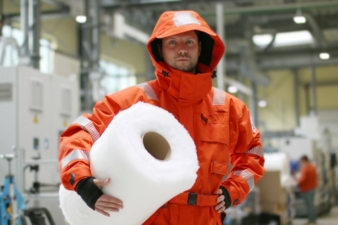04/12/2019 – Closing the gap and avoiding the ‘valley of death’ — auf Deutsch lesen
Focus on Rudolstadt: OMPG
Most of the sixteen German textile research institutes formed research and production companies some years ago.
The Thuringian Institute for Man-Made Fibre Technology (TITK) operates a materials testing subsidiary for textiles and plastics whose name – Ostthüringische Materialprüfgesellschaft für Textil- und Kunststoffe – is admittedly quite a mouthful which is why it is simply referred to as OMPG for short.
Melamine nonwoven
Equipped with world innovations for products and processes, the first appearance of the OMPG’s subsidiary smartpolymer at Techtextil North America in Atlanta in 2018 proved to be a resounding success. Managing Director Christoph Löning made the journey together with half a dozen staff. In the run-up to the event, the undertaking was considered bold, but when visitors started flocking to the stand in droves, it was soon regarded as a decision made with considerable foresight. The main focus of interest was the heatproof smartMelamine-Meltblown Nonwoven. The production of preliminary products from the non-flammable and patented material had only just started in Slovenia when Atlanta came around. Why Slovenia? It was here that the TITK Group founded the company smartMelamine in collaboration with a Slovenian chemical manufacturer. The nonwoven, which was created by TITK researchers, in-house technicians and industry practitioners from Austria, neither burns nor does it melt when exposed to heat, it is chemically stable, extremely lightweight, resistant to UV light and is endowed with excellent insulating properties. This makes it the perfect material for protective clothing for firefighters and for applications designed for fire prevention, and thermal and acoustic insulation.
The demand for the nonwoven and its unique features is so strong that production capacities in Koijevje are being stepped up again to 1,000 to 2,000 tonnes per year. Benjamin Redlingshöfer, one of the two TITK Directors and Co-Director of smartpolymer, states:
“We’re not just talking about market transfer because we’re also in a position to advance important research results to the production stage. In doing so, we instil confidence in our customers whilst underscoring our expertise also in this field.”
With its unique specialisation in the research of polymers, the institute provides plenty of input for the subsidiary. The new 3D Technical Centre, for example, has developed an innovative polymer resin adhesive which welds textiles together permanently. The bicomponent adhesive has different melting points and is applied by a 3D printer. Applications in rail, aviation and filtration are envisaged with a new subsidiary possibly in the pipeline.
OMPG
Established back in 1992, OMPG is constantly expanding its portfolio for monitoring textiles, fibre composite materials and plastics. It is currently focusing on the testing of antibacterial plastics and textiles as well as bio-compatibility tests with cell cultures. OMPG is accredited in compliance with DIN EN ISO/IEC 17025.
Daimler recently carried out a successful audit at OMPG, following the expansion of the latter’s laboratory which provides testing services for plastics processors and suppliers to the automotive industry. The methods approved by the automotive maker from Stuttgart were in compliance with Class A and include fire and almost all emissions tests. After participating in a large-scale round-robin trial, OMPG successfully qualified for emissions testing for Volkswagen. The materials testing institute now has the authorisation it needs to carry out the full range of emissions tests, including fogging, organic compounds and odours in vehicle interiors.
OMPG is currently collaborating, among others, with the fzmb research centre for medical and bio-technology in Bad Langensalza (Germany). The objective of the project is to create an electronic nose – i.e. sensor technology endowed with artificial intelligence. It is to be used in automotive production, specifically for the “composition” of the “new-car fragrance”. Until now, the emissions from materials for car interiors have been “sniffed” by humans. However, it now seems more than likely that the need for human noses will soon be a thing of the past.




